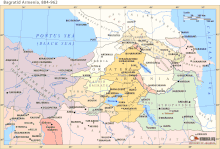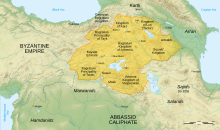Bagratuni dynasty
[11] Historian Cyril Toumanoff speculated that a general of King Tigranes II of Armenia (r. 95 – 55 BCE) named Bagadates may have been the earliest known member of the Bagratuni family,[12] which first emerged as nakharars—members of the hereditary nobility of Armenia—in the early 4th century.After the failed rebellion, the Bagratunis lost control of their domains of Tmorik, Kogovit and their possessions in Vaspurakan, although their losses were less severe than those of the other Armenian noble families.[16] Smbat VII's son Ashot Msaker restored the fortunes of the dynasty in the 9th century by waging war against the local Arab emir while remaining loyal to the Abbasid caliphs.Eventually, some noble families such as the Artsrunis and the Siunis broke off from the central Bagratid authority, founding the separate kingdoms of Vaspurakan and Syunik, respectively.[2] However, with the start of the 10th century and on, the Bagratunis broke up into different branches, fragmenting the kingdom in a time when unity was needed in the face of Seljuk and Byzantine pressure.The junior Kiurikian branch of the Bagratunis continued to rule as independent kings of Tashir-Dzoraget until 1118 and Kakheti-Hereti until 1104, and thereafter as rulers of smaller principalities centered on their fortresses of Tavush and Matsnaberd until the 13th century Mongol conquest of Armenia.






Bagratuni family treeArmeniaGagik IIKing of KingsIberiaArmenianKing of ArmeniaKing of ArtsakhKing of VaspurakanKing of SyunikKing of LoriPrince of VanandPrince of TaronPrince of KhachenPrince of TaykBagrationisRubenidsHasan-JalalyanKiurikiansSmbat IIKiurike IHaghpat Monasterymedieval Kingdom of ArmeniaKingdom of Armenia of antiquityArab rule in ArmeniaShirakBagrevandSyunikVaspurakanVanandCyril ToumanoffNicholas AdontzRonald SunyBagrationi dynastyOrigin of the Bagratid dynastiesParthianOld IranianTigranes IInakhararsArshakuni (Arsacid) dynastyChristianityÇoruh RiverUpper ArmeniaMovses KhorenatsiOrontidsArab conquest of ArmeniaishkhanostikanMamikoniansUmayyad ruleAshot IIIAbbasidssparapetSmbat VII BagratuniAbbasid CaliphateBattle of BagrevandMushegh MamikonianTmorikAshot MsakerBagrat IISmbat "the Confessor"Ashot ITiflisParisosKartliKakhetiCaucasian Albania AlbaniaBaghdadConstantinopleArtsrunisSiunisAshot III the MercifulByzantine EmpireShahanshahKiurikianTashir-DzoragetKakheti-Heretidynasty of Cilician ArmeniaArmenian KingdomCiliciaRuben IShaddadidHistory of ArmeniaPrehistoryShulaveri–Shomu cultureKura–Araxes cultureLegend of HaykTrialeti–Vanadzor cultureArmaniLchashen–Metsamor cultureHayasa-AzziArme–ShupriaMushkiNairi ConfederationUrartu (Kingdom of Van)EtiuniAntiquitySatrapy of ArmeniaArmenia MinorKingdom of ArmeniaArmenian EmpireRoman ArmeniaChristianization of ArmeniaKingdom of SopheneCommageneByzantine ArmeniaSasanian ArmeniaMuslim conquest of ArmeniaMiddle AgesEmirate of ArmeniaPrincipality of HamamshenKingdom of VaspurakanKingdom of Tashir-DzoragetKingdom of SyunikKingdom of ArtsakhZakarid ArmeniaPrincipality of KhachenMongol ArmeniaKingdom of CiliciaIranian ArmeniaFive MelikdomsOttoman ArmeniaRussian ArmeniaArmenian OblastArmenian questionArmenian genocide